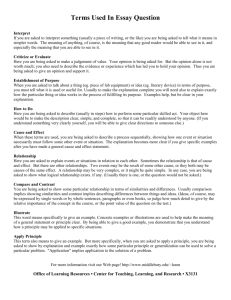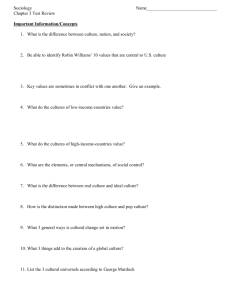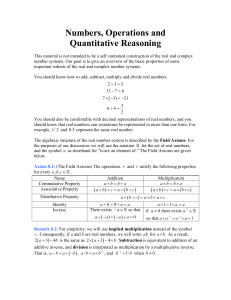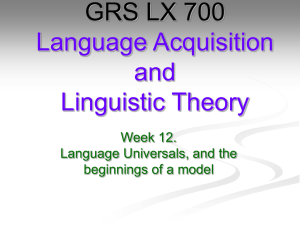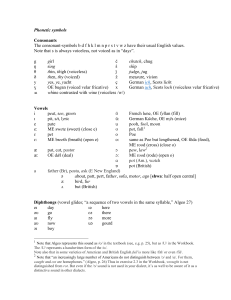PowerPoint
advertisement
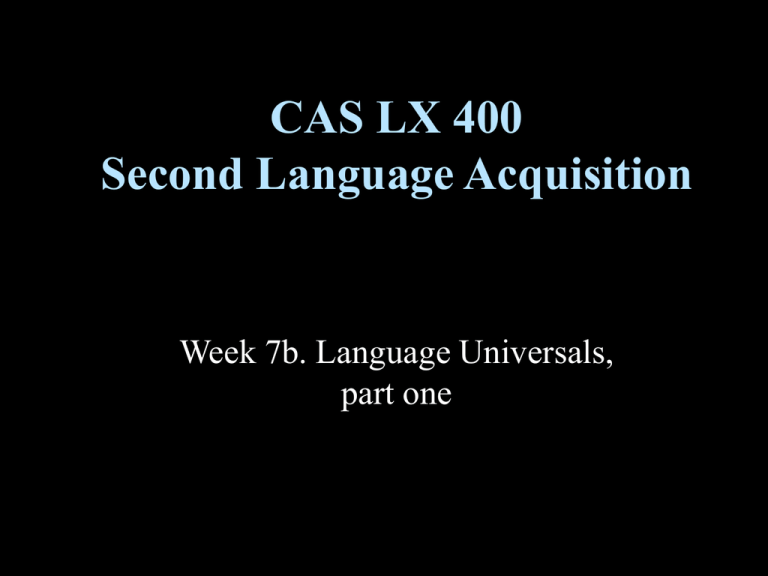
CAS LX 400
Second Language Acquisition
Week 7b. Language Universals,
part one
Typological universals
• 1960’s and 1970’s saw a lot of activity
aimed at identifying language universals,
properties of Language.
• Class of possible languages is smaller than
you might think.
• If a language has one property (A), it will
necessarily have another (B).
– +A+B, –A–B, –A+B but never +A–B.
(Typological) universals
• All languages have vowels.
• If a language has VSO as its basic word order,
then it has prepositions (vs. postpositions).
VSO?
Adposition type
Yes (VSO) No
Prepositions
Postpositions
Welsh
None
English
Japanese
Markedness
• Having duals implies having plurals
• Having plurals says nothing about having duals.
• Having duals is marked—infrequent, more
complex. Having plurals is (relative to having
duals) unmarked.
• Generally markedness is in terms of comparable
dimensions, but you could also say that being
VSO is marked relative to having prepositions.
Berlin & Kay 1969: Color terms
• (On the boundaries of psychophysics,
linguistics, anthropology, and with issues
about its interpretation, but still…)
• Basic color terms across languages.
• It turns out that languages differ in how
many color terms count as basic. (blueish,
salmon-colored, crimson, blond, … are not
basic).
Berlin & Kay 1969: Color terms
• The segmentation of experience by speech symbols is
essentially arbitrary. The different sets of words for
color in various languages are perhaps the best ready
evidence for such essential arbitrariness. For example,
in a high percentage of African languages, there are
only three “color words,” corresponding to our white,
black, red, which nevertheless divide up the entire
spectrum. In the Tarahumara language of Mexico, there
are five basic color words, and here “blue” and “green”
are subsumed under a single term.
– Eugene Nida (1959)
Berlin & Kay 1969: Color terms
•
•
•
•
•
•
•
•
•
•
Arabic (Lebanon)
Bulgarian (Bulgaria)
Catalan (Spain)
Cantonese (China)
Mandarin (China)
English (US)
Hebrew (Israel)
Hungarian (Hungary)
Ibibo (Nigeria)
Indonesian (Indonesia)
•
•
•
•
•
•
•
•
•
•
Japanese (Japan)
Korean (Korea)
Pomo (California)
Spanish (Mexico)
Swahili (East Africa)
Tagalog (Philippines)
Thai (Thailand)
Tzeltal (Southern Mexico)
Urdu (India)
Vietnamese (Vietnam)
Eleven possible basic color terms
• White, black, red, green, yellow, blue, brown, purple,
pink, orange, gray.
• All languages contain term for white and black.
• Has 3 terms, contains a term for red.
• Has 4 terms, contains green or yellow.
• Has 5 terms, contains both green and yellow.
• Has 6 terms, contains blue.
• Has 7 terms, contains brown.
• Has 8 or more terms, chosen from {purple, pink,
orange, gray}
Color hierarchy
•
•
•
•
•
•
White, black
Red
Green, yellow
Blue
Brown
Purple, pink, orange, gray
• Even assuming these 11 basic color terms, there
should be 2048 possible sets—but only 22 (1%)
are attested.
Color terms
• BW
• BWR
•
•
•
•
•
Jalé (New Guinea) ‘brilliant’ vs. ‘dull’
Tiv (Nigeria), Australian aboriginals in
Seven Rivers District, Queensland.
BWRG
Ibibo (Nigeria), Hanunóo (Philippines)
BWRY
Ibo (Nigeria), Fitzroy River people (Queensland)
BWRYG Tzeltal (Mexico), Daza (eastern Nigeria)
BWRYGU Plains Tamil (South India), Nupe (Nigeria), Mandarin?
BWRYGUO Nez Perce (Washington), Malayalam (southern India)
Color terms
• Interesting questions abound, including why this
order, why these eleven—and there are potential
reasons for it that can be drawn from the
perception of color spaces which we will not
attempt here.
• The point is: This is a fact about Language: If
you have a basic color term for blue, you also
have basic color terms for black, white, red,
green, and yellow.
Implicational hierarchy
• This is a ranking of markedness or an implicational
hierarchy.
• Having blue is more marked than having (any or all of)
yellow, green, red, white, and black.
• Having green is more marked than having red…
• Like a set of implicational universals…
–
–
–
–
–
Blue implies yellow
Blue implies green
Yellow or green imply red
Red implies black
Red implies white
Brown implies blue
Pink implies brown
Orange implies brown
Gray implies brown
Purple implies brown
L2A?
• Our overarching theme:
How much is L2/IL like a L1?
• Do IL/L2 languages obey the language
universals that hold of native languages?
• This question is slightly less theory-laden than
the questions we were asking about principles
and parameters, although it’s similar…
• To my knowledge nobody has studied L2
acquisitions of color terms…
Question formation
• Declarative: John will buy coffee.
• Wh-inversion: What will John buy?
• Wh-fronting: What will John buy?
• Yes/No-inversion: Will John buy coffee?
• Greenberg (1963):
– Wh-inversion implies Wh-fronting.
– Yes/No-inversion implies Wh-inversion.
Wh-inversionWh-fronting
• English, German: Both.
– What will John buy?
• Japanese Korean: neither.
– John will buy what?
• Finnish: Wh-fronting only.
– What John will buy?
• Unattested: Wh-inversion only.
– *Will John buy what?
Y/N-inversionWh-inversion
• English: Both
– Will John buy coffee? What will John buy?
• Japanese: Neither
– John will buy coffee? John will buy what?
• Lithuanian: Wh-inversion only.
– John will buy coffee? What will John buy?
• Unattested: Y/N-inversion only.
– Will John buy coffee? What John will buy?
Eckman, Moravcsik, Wirth
(1989)
• L1: Korean (4), Japanese (6), Turkish (4)
• L2: English
• Note L1s chosen because they are
neither/neither type languages, to avoid
questions of transfer.
• Subjects tried to determine what was going
on in a scene by asking questions.
Eckman, Moravcsik, Wirth
(1989)
• Example Y/N Qs:
–
–
–
–
–
–
–
Did she finished two bottle wine?
Is Lou and Patty known each other?
Sue does drink orange juice?
Her parents are rich?
Is this story is chronological in a order?
Does Joan has a husband?
Yesterday is Sue did drink two bottles of wine?
Eckman, Moravcsik, Wirth
(1989)
• Example Wh-Qs:
–
–
–
–
–
–
–
Why Sue didn’t look solution for her problem?
Where Sue is living?
Why did Sue stops drinking?
Why is Patty’s going robbing the bank?
What they are radicals?
What Sue and Patty connection?
Why she was angry?
Eckman,
Moravcsik,
Wirth (1989)
wh-inversion
implies
wh-fronting?
results
%
WHINV %
WHFR
SM K
25
NO
100
YES
UA T
54
NO
100
YES
TS
70
NO
100
YES
MK K
80
NO
100
YES
RO J
88
NO
100
YES
KO J
95
YES
100
YES
MH J
95
YES
100
YES
NE
T
95
YES
100
YES
SI
J
95
YES
100
YES
G
T
100
YES
100
YES
MA T
100
YES
100
YES
ST
100
YES
100
YES
TM K
100
YES
100
YES
YK J
100
YES
100
YES
J
J
Eckman,
Moravcsik,
Wirth (1989)
YN-inversion
implies
wh-inversion?
results
%
YNINV
%
WHINV
SM K
8
NO
25
NO
MK K
38
NO
80
NO
YK J
51
NO
100 YES
TS
67
NO
70
TM K
83
NO
100 YES
RO J
85
NO
88
BG T
86
NO
100 YES
MA T
88
NO
100 YES
UA T
91
YES
54
NO
KO J
93
YES
95
YES
MH J
95
YES
95
YES
NE
T
100
YES
95
YES
SI
J
100
YES
95
YES
ST
J
100
YES
100 YES
J
NO
NO
Eckman, Moravcsik, Wirth
(1989)
Yes/no inversion
Wh-inversion
Yes (VS)
No (SV)
Yes (VS)
5
4
No (SV)
1
4
Eckman’s Markedness
Differential Hypothesis
• Markedness. A phenomenon or structure X in
some language is relatively more marked than
some other phenomenon or structure Y if crosslinguistically the presence of X in a language
implies the presence of Y, but the presence of Y
does not imply the presence of X.
– Duals imply plurals.
– Wh-inversion implies wh-fronting.
– Blue implies red.
Markedness Differential Hypothesis
• MDH: The areas of difficulty that a second language
learner will have can be predicted on the basis of a
comparison of the NL and TL such that:
– Those areas of the TL that are different from the NL and
are relatively more marked than in the NL will be
difficult;
– The degree of difficulty associated with those aspects of
the TL that are different and more marked than in the NL
corresponds to the relative degree of markedness
associated with those aspects;
– Those areas of the TL that are different than the NL but
are not relatively more marked than in the NL will not be
difficult.
MDH vs. CAH
– Those areas of the TL that are different from the
NL and are relatively more marked than in the NL
will be difficult;
• The MDH is a bit better than its predecessor,
the Contrastive Analysis Hypothesis because it
anticipates (and attempts to systematically
predict) that not every difference between TL
and NL cause learners difficulty.
MDH example:
Word-final segments
•
•
•
•
Voiced obstruents
Voiceless obstruents
Sonorant consonants
Vowels
most marked
least marked
Surge
Coke
Mountain
Coffee
• All Ls allow vowels word-finally—some only allow
vowels. Some (e.g., Mandarin, Japanese) allow only
vowels and sonorants. Some (e.g., Polish) allow
vowels, sonorants, but only voiceless obstruents.
English allows all four types.
Eckman (1981)
e
e
IL form
[b p]
[b bi]
[rt]
[w t]
[sIk]
Mandarin L1
Gloss
IL form
Tag
[tæg ]
And
[ænd ]
Wet
[w t]
Deck
[dk]
Letter
[lt r]
Bleeding
[blidIn]
e
e
c
c
e
Spanish L1
Gloss
Bob
Bobby
Red
Wet
Sick
MDH example:
Word-final segments
•
•
•
•
Voiced obstruents
Voiceless obstruents
Sonorant consonants
Vowels
most marked
least marked
Surge
Coke
Mountain
Coffee
• Idea: Mandarin has neither voiceless nor voiced obstruents
in the L1—using a voiceless obstruent in place of a TL
voiced obstruent is still not L1 compliant and is a big
markedness jump. Adding a vowel is L1 compliant. Spanish
has voiceless obstruents, to using a voiceless obstruent for a
TL voiced obstruent is L1 compliant.
MDH and IL
• The MDH presupposes that the IL obeys the
implicational universals too.
• Eckman et al. (1989) suggests that this is at least
reasonable.
• The MDH suggests that there is a natural order
of L2A along a markedness scale (stepping to
the next level of markedness is easiest).
• Let’s consider what it means that an IL obeys
implicational universals…
MDH and IL
• IL obeys implicational universals.
• That is, we know that IL is a language.
• So, we know that languages are such that
having word-final voiceless obstruents
implies that you also have word-final
sonorant consonants, among other things.
• What would happen if we taught Japanese
L2 learners of English only—and at the
outset—voiced obstruents?
Generalizing with markedness
scales
•
•
•
•
Voiced obstruents
Voiceless obstruents
Sonorant consonants
Vowels
most marked
least marked
Surge
Coke
Mountain
Coffee
• Japanese learner of English will have an easier time at
each step learning voiceless obstruents and then voiced
obstruents.
• But—if taught voiced obstruents immediately, the fact
that the IL obeys implicational (markedness) universals
means that voiceless obstruents “come for free.”
Nifty!
• Does it work? Does it help?
• Answers seem to be:
– Yes, it seems to at least sort of work.
– Maybe it helps.
• Point is: Learning a marked structure is harder.
So, if you learn a marked structure, you can
automatically generalize to the less marked
structures, but was it faster than learning the
easier steps in succession would have been?
Change between pre- & post-test
Eckman, Bell, and Nelson (1988)
8
7
6
5
Subj Group
Obj Group
O.P. Group
Controls
4
3
2
1
0
Subj
Obj
O.P.
The Noun Phrase Accessibility
Hierarchy
• Keenan & Comrie (1977) observed a hierarchy among the
kinds of relative clauses that languages allow.
• The astronaut [(that) I met yesterday].
• Head noun: astronaut
• Modifying clause:
(that/who) I met — yesterday.
• Compare: I met the astronaut yesterday.
• This is an object relative because the place where the head
noun would be in the simple sentence version is th object.
The Noun Phrase Accessibility
Hierarchy
• There are several kinds of relative clauses, based
on where the head noun “comes from” in the
modifying clause:
• The astronaut…
–
–
–
–
–
–
[I met — yesterday]
[who — met me yesterday]
[I gave a book to —]
[I was talking about —]
[whose house I like —]
[I am braver than —]
object
subject
indirect object
obj. of P
Genitive (possessor)
obj. of comparative
The Noun Phrase Accessibility
Hierarchy
• Turns out: Languages differ in what positions
they allow relative clauses to be formed on.
• English allows all the positions mentioned to
be used to make relative clauses.
• Arabic allows relative clauses to be formed
only with subjects.
• Greek allows relative clauses to be formed
only with subjects or objects.
Resumptive pronouns
• The guy who they don’t know whether he wants to
come.
• A student who I can’t make any sense out of the papers
he writes.
• The actress who Tom wondered whether her father was
rich.
• In cases where relative clause formation is not allowed,
it can sometimes be salvaged by means of a pronoun in
the position that the head noun is to be associated with.
NPAH and resumptive pronouns
• Generally speaking, it turns out that in languages which
do not allow relative clauses to be formed off a certain
position, they will instead allow relative clauses with a
resumptive pronoun in that position.
• Arabic: allows only subject relative clauses. But for all
other positions allows a resumptive pronoun
construction, analogous to:
– The book that John bought it.
– The tree that John is standing by it.
– The astronaut that John gave him a present.
NPAH
• The positions off which you can relativize
appears to be an implicational hierarchy.
Language
Arabic
Greek
Japanese
Persian
SUB
–
–
–
–
DO
+
–
–
(+)
IO
+
+?
–
+
OP
+
+?
–
+
GEN
+
+
+/ –
+
OCOMP
+
+
+
NPAH in L2A
• Very widely studied implicational universal
in L2A—many people have addressed the
question of whether the IL obeys the NPAH
and whether teaching aa marked structure
can help.
• Eckman et al. (1989) was about this second
question…
Change between pre- & post-test
Eckman, Bell, and Nelson (1988)
8
7
6
5
Subj Group
Obj Group
O.P. Group
Controls
4
3
2
1
0
Subj
Obj
O.P.
Next week
• Anna Do, graduate student in the Applied
Linguistics program here at BU, has looked at
this question focusing on English speakers
learning Korean, trying to determine (a) whether
the learners’ IL obey the NPAH, and (b) to what
extent there is transfer of the position of the L1
on the NPAH to the IL (where the TL is at a
different position).
• Next week, she’ll be here to tell us about her
experiment and her results.
